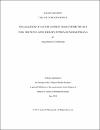VISUALIZATION OF FACTOR VIII WITH FLOW-CYTOMETRY AS A TOOL FOR NOVEL GENE THERAPY APPROACH IN HEMOPHILIA A
| Advisor | Malki, Ahmed |
| Advisor | Deola, Sara |
| Author | Al-Mohannadi, Anjud Khamis |
| Available date | 2019-07-29T04:47:35Z |
| Publication Date | 2019-07 |
| Abstract | Haemophilia A is a genetic X-linked disorder, characterized by coagulation Factor VIII (FVIII) deficiency and leading to pathological bleedings. The disease occurs in a rate of 1 in 5000 males’ births. The treatment is the administration of plasma-derived or recombinant Factor VIII which is expensive and leads to the development of inhibitory antibodies in around 40% of patients affected by the severe form of the disease. The disease becomes for these patients life-threatening. New approaches to treat Haemophilia include Gene Therapy (GT). Cells corrected through genetic modifications are used to produce in Haemophilia A patients FVIII protein in a sustained manner, as long-term treatment for this disorder. The cells of choice should be persistent and equipped with the machinery for large protein assembly and secretion. So far, target cells for Haemophilia gene correction are mostly liver cells, although they are highly immunogenic and exposed to immune-mediated destruction after GT. Based on literature evidences, Bone Marrow Transplantation can correct Haemophilia A in mice, providing evidence that Hematopoietic Stem Cells (HSC) or their progeny are able to produce FVIII. We chose the approach of correcting HSC with lentiviral vectors carrying the FVIII gene cassette. Whereas classically FVIII protein is visualized on adherent cells through immunohistochemistry staining, Flow-Cytometry (FC) literature publications are very scarce. FC analysis is an attractive method for analysing hematopoietic cells, and in general, a versatile method for protein visualization. However, large proteins as FVIII are difficult to be carefully analysed, and the method requires several steps of optimization. This joint project with Dr. Muhammad Elnaggar, (postdoctoral fellow) .aims to optimize a method to characterize large proteins as FVIII with a reliable FC staining protocol. To this aim we used cell lines to evaluate the expression and secretion pathways of FVIII, the intracellular requirements to fold and secrete large proteins, and the toxicities of protein accumulation, in case of GT mediated protein overexpression. To this aim, the FC experiments were performed to optimise the FC protocol for FVIII visualization, by improving blocking efficacy, antibody labelling efficacy and to ensure accuracy and validity through qPCR and FC double staining. This FC protocol proved its validity and usefulness in visualizing and studying functionally FVIII. The project successfully facilitated safe GT protocols in HSC, moreover, addressed the need in the field of biomedical research by optimizing a reliable FC protocol of staining and visualization of large proteins like FVIII. |
| Language | en |
| Subject | Haemophilia A Factor VIII (FVIII) Flow-Cytometry (FC) Hematopoietic Stem Cells |
| Type | Master Thesis |
| Department | Biomedical Sciences |
Files in this item
This item appears in the following Collection(s)
-
Biomedical Sciences [58 items ]


